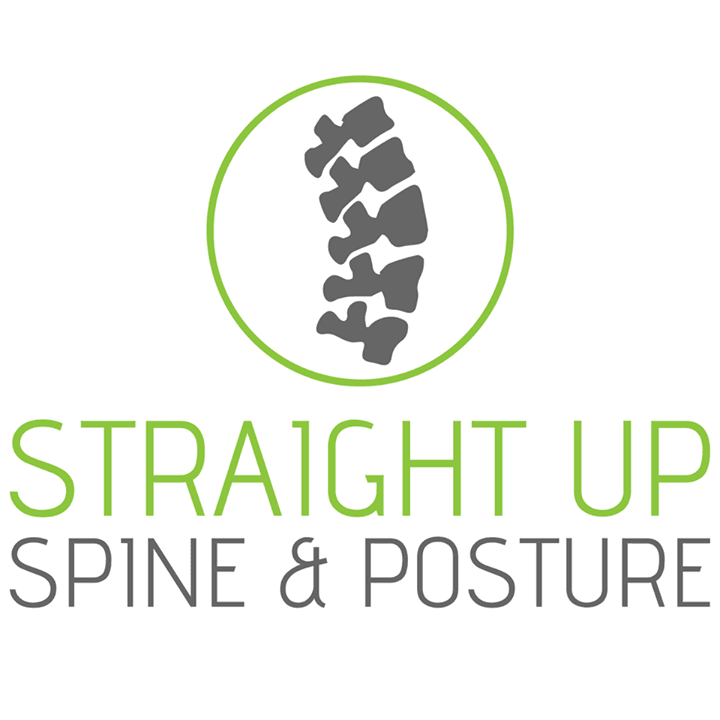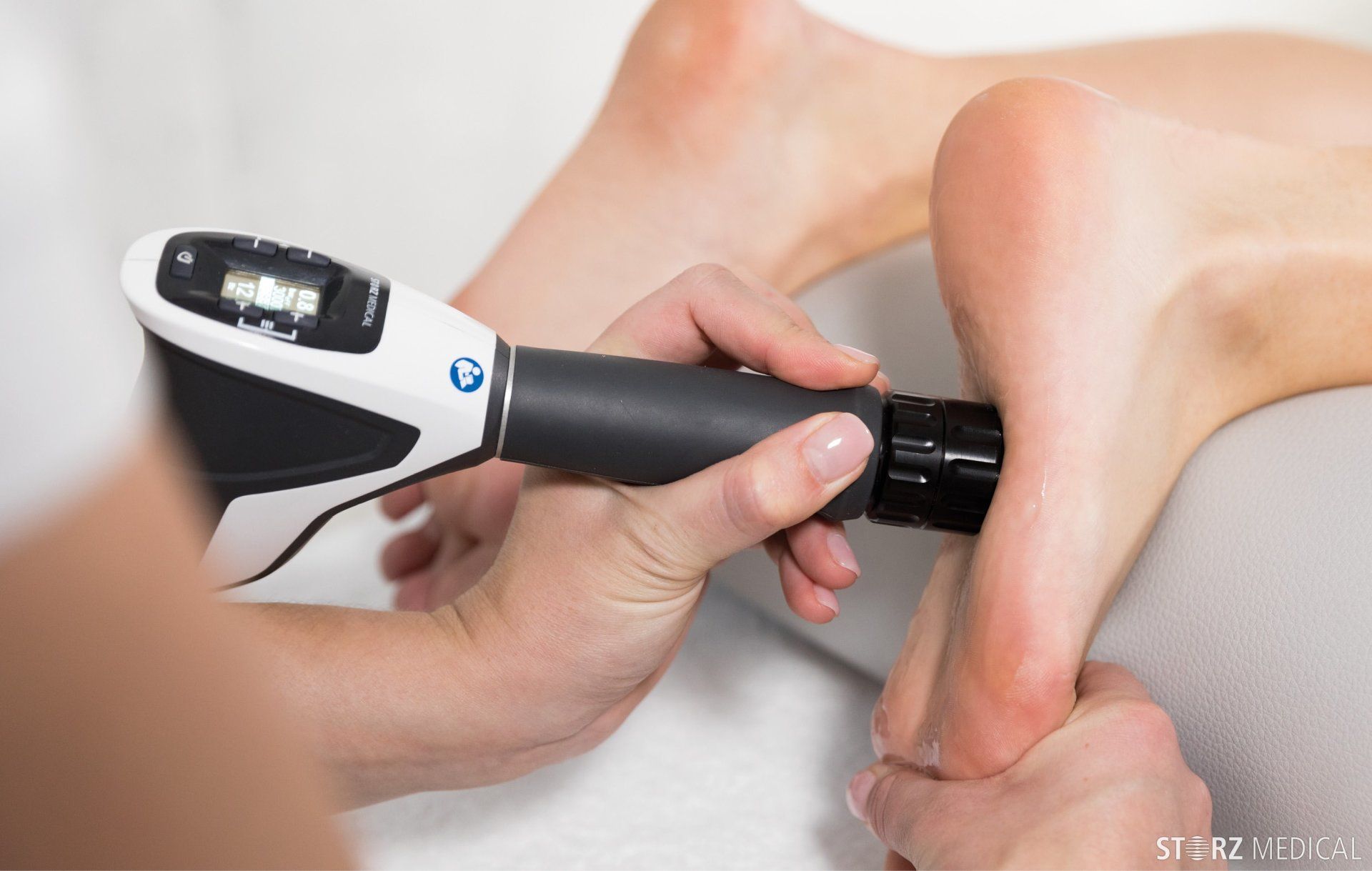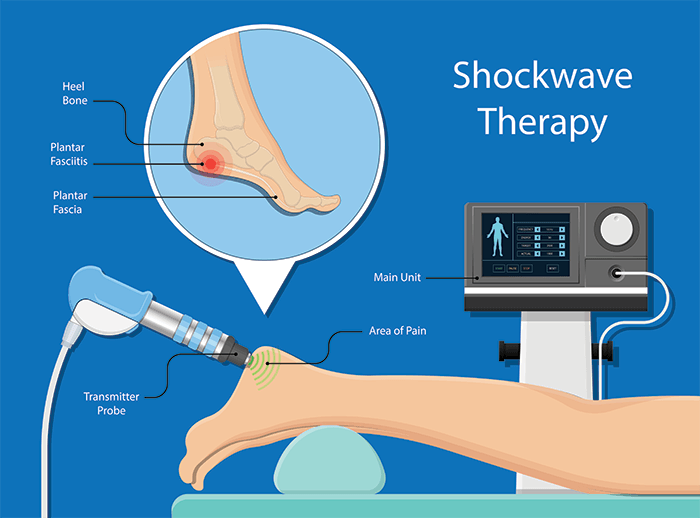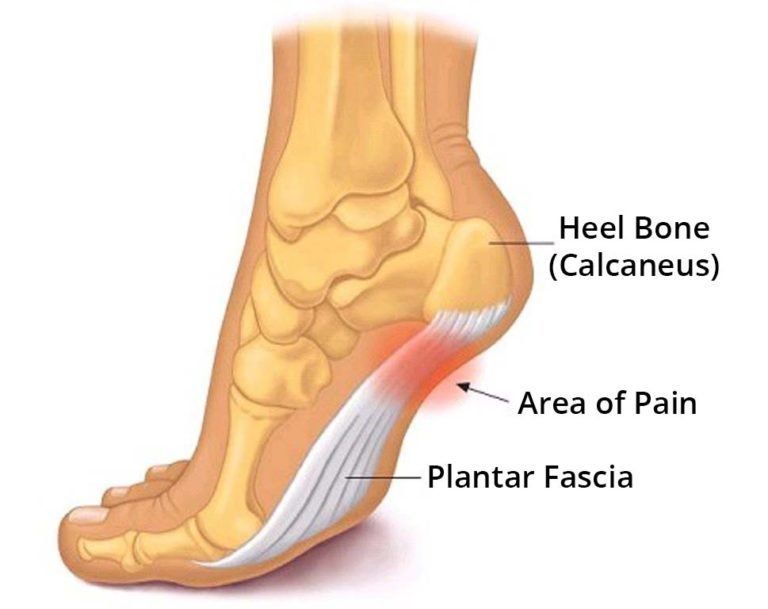We Have a Real and Proven Treatment. You Probably Wouldn't Be Reading This If You Didn't Have Plantar Fasciitis, so Don't Waste Your Time or Money on Orthotics or Injections (Which Probably Won't Work as Well).
Most people learn about non-surgical extracorporeal shockwave therapy after experiencing chronic and painful plantar fasciitis. Most of these people have tried orthotics, injections, or physical therapy in the past, and may have tried massage or some type of brace as well. If that sounds like you, then you're probably in the right place.
We purchased our first shockwave machine in 2020 and have been extremely impressed by the results we consistently get. Our typical patient is usually referred to us by frustrated local physical therapists, podiatrists, and medical doctors. When they can't get results with their methods, they send their tough cases to us for shockwave therapy.
What Exactly is Shockwave Therapy?
Shockwave therapy is a pretty confusing term. It kind of sounds like ultrasound, but it isn't. It is officially named Extracorporeal ShockWave Therapy (ESWT), also known as Extracorporeal Pressure Activation Technology (EPAT), or Acoustic Wave Therapy (AWT). To make things more confusing there are two types: Focused, and Radial.
Don't worry about the name. This non-surgical therapy essentially breaks up scar tissue and stimulates tendons to grow and heal. This is accomplished by pulsing a very short but very strong pressure wave into the tissue. This rapid increase and decrease in pressure causes a deep stretching which loosens tough tissue and causes tiny blood vessels to grow into the tissue. Essentially, shockwave therapy is a very advanced form of massage and regenerative medicine.
The basic idea is that a chronic tendon, ligament, or fascia injuries don't heal on their own. Traditionally, surgery would be used to cut out the damaged part and rejoin the undamaged parts.
Scockwave therapy is a treatment which causes the small tears in the plantar fascia to heal. This should relieve pain and improve your ability to walk. The image below shows how the therapy works. It is very simple and very tolerable.
Who is a candidate for shockwave therapy?
The worse the better. This is important! Shockwave therapy works best for chronic foot or heel pain. The best course of action for the first episode of plantar fasciitis is simple rest and ice. Research suggests that plantar fasciitis which fails to resolve on it's own or continues to impair your activities will respond well to shockwave therapy.
Many of our patients are unsure if their pain is due to plantar fasciitis, a heel spur, some type of joint issue, or even a fracture. The good news is that shockwave can be used to treat all of these. Even though we do not treat fractures with shockwave, it has been shown to increase the healing rate of fractures.
An ideal shockwave therapy candidate has either struggled with ongoing plantar fasciitis or has failed to get improvement with other treatments.
There are studies which show that shockwave therapy is more effective than cortisone/steroid injections, stretching and exercise, and even surgery. We work with patients who are frustrated that one of their prior doctors hadn't suggested shockwave therapy even though their $1,000+ treatments didn't work.
We believe that shockwave works best when it is paired with an active rehabilitation program to improve foot, ankle, and general leg strength and mobility. There are several excellent local physical therapists we can refer you to, if you are interested in maximizing your treatment.
- Shockwave therapy works best on chronic plantar fasciitis.
- It works by accelerating the healing process and allowing chronic injuries to finally heal.
- Rehabilitation programs for improving foot and leg biomechanics can be done at the same time.
An Overview of Shockwave Therapy:
Shockwave therapy takes 5-10 minutes per session. Most patients require an average of six visits, which is what we recommend for plantar fasciitis. Treatment is performed once per week. The majority of patients experience a significant reduction in pain and they are able to return to sports or increased activity within 8 weeks of their first treatment. Some patients experience a significant improvement after their first session.
When being treated with shockwave therapy, a patient lies face down on a table. The symptomatic foot is raised slightly in the air and the shockwave applicator is placed over the damaged area of the plantar fascia. The unit is activated and begins to produce between 4 and 20 shockwaves per second, depending on the patient's tolerance. The intensity of the shockwaves can be adjusted from very light to extremely strong. The first session is generally spent familiarizing the patient with the treatment so they know what to expect during their second treatment.
Once a patient is comfortable with the pressure, the applicator is slowly moved around the area of pain. This part of treatment is very interesting. In most cases, a patient can identify the exact point which is responsible for their pain. It may be very painful at first. Once this point is located, the applicator is held there for 20-40 seconds. During this time the pain in this area will reduce to a very mild level. This is one of the potential benefits of radial shockwaves. Patients can help to identify the exact area of pain. This does not happen with the other type of shockwaves (focused) which require local anesthesia.
How Does Shockwave Therapy Heal Plantar Fasciitis?

Shockwave therapy works by inducing "mechanotransduction" in the plantar fascia. The concept of mechanotransduction is simple; when a tissue experiences a particular type of physical stimulation, it responds by producing some sort of change. A familiar example is resistance exercise. When a muscle is subjected to a strong stretch microtears occur in the muscle and it responds by growing larger and stronger. Connective tissue like the plantar fascia, tendons, and ligaments are not the same as muscles and cannot be easily induced to grow though simple stretching, massage, or manual therapies.
The rapid pressure wave produced by a shockwave machine creates very short bursts (1/10,000th of a second) of very high pressure. This rapid increase in pressure creates a short negative pressure which essentially expands the tissue from the inside-out. The animation above demonstrates this. An ultra high-speed video shows the creation of tiny cavitation bubbles. These bubbles form in water when an extremely high and short pressure pulse moves through it.
The end result of this mechanotransduction is the generation of the healing response. Tiny blood vessels begin to grow into the tissue. Growth factors similar to growth hormone are released from the treated tissue. Tough scar tissue is physically loosened which reduces focused and repetitive tearing at the site of the injury.
How Does Shockwave Therapy Compare to Other Treatments?
According to a study published in Pain Medicine titled "Extra Corporeal Shock Wave Therapy Versus Local Corticosteroid Injection in the Treatment of Chronic Plantar Fasciitis, a Single Blinded Randomized Clinical Trial" shockwave therapy is safer, requires less rest, has less risk, and has better long-term results.
Corticosteroid injection requires a period of rest after administration, while radial ESWT has benefits of no immobilization and early return to work. Although pain occurs during the therapy session in both treatments, the pain during injection is greater than pain in radial ESWT.
Corticosteroid injection, and mainly multiple injections, may cause rare complications such as plantar fascia rupture, fat pad atrophy, medial plantar nerve injury secondary to injection, or calcaneal osteomyelitis.
There is a high frequency of relapse and recurrence following treatment with corticosteroid. In addition, some previous studies indicate better long-term efficacy for ESWT, but not for corticosteroid injection.
Browse some of the research articles listed at the bottom of this page if you are interested in the hard science behind shockwave therapy. It consistently proves to be more effective than standard treatments, especially in chronic cases.
Find Out If You Are A Candidate For Shockwave Therapy
The process for determining whether you might benefit from shockwave therapt starts with a short examination with Dr. Ryan Winslow. Luckily, plantar fasciitis is very easy to identify and complicated diagnostic procedures are generally not required. Therapy can be given on the same day as the exam. You can set an appointment through one of the following ways:
- Call us at 224-656-5778 to schedule an appointment.
- Email us at info@straightupspineandposture.com
References
1. Genc H, Saracoglu M, Nacir B, et al. Long-term ultrasonographic follow-up of plantar fasciitis patients treated with steroid injection. Joint Bone Spine. 2005;72(1):61–65. doi: 10.1016/j.jbspin.2004.03.006. [PubMed] [CrossRef] [Google Scholar]
2. Gross MT, Byers JM, Krafft JL, et al. The impact of custom semirigid foot orthotics on pain and disability for individuals with plantar fasciitis. J Orthop Sports Phys Ther. 2002;32(4):149–157. doi: 10.2519/jospt.2002.32.4.149. [PubMed] [CrossRef] [Google Scholar]
3. Lynch DM, Goforth WP, Martin JE, et al. Conservative treatment of plantar fasciitis. A prospective study. J Am Podiatr Med Assoc. 1998;88(8):375–380. doi: 10.7547/87507315-88-8-375. [PubMed] [CrossRef] [Google Scholar]
4. Powell M, Post WR, Keener J, et al. Effective treatment of chronic plantar fasciitis with dorsiflexion night splints: a crossover prospective randomized outcome study. Foot Ankle Int. 1998;19(1):10–18. doi: 10.1177/107110079801900103. [PubMed] [CrossRef] [Google Scholar]
5. DiGiovanni BF, Nawoczenski DA, Lintal ME, et al. Tissue-specific plantar fascia-stretching exercise enhances outcomes in patients with chronic heel pain. A prospective, randomized study. J Bone Joint Surg Am. 2003;85-A(7):1270–1277. doi: 10.2106/00004623-200307000-00013. [PubMed] [CrossRef] [Google Scholar]
6. Landorf KB, Radford JA, Keenan AM, et al. Effectiveness of low-Dye taping for the short-term management of plantar fasciitis. J Am Podiatr Med Assoc. 2005;95(6):525–530. doi: 10.7547/0950525. [PubMed] [CrossRef] [Google Scholar]
7. Böddeker R, Schäfer H, Haake M. Extracorporeal shockwave therapy (ESWT) in the treatment of plantar fasciitis—a biometrical review. Clin Rheumatol. 2001;20(5):324–330. doi: 10.1007/PL00011207. [PubMed] [CrossRef] [Google Scholar]
8. Buchbinder R, Ptasznik R, Gordon J, et al. Ultrasound-guided extracorporeal shock wave therapy for plantar fasciitis: a randomized controlled trial. JAMA. 2002;288(11):1364–1372. doi: 10.1001/jama.288.11.1364. [PubMed] [CrossRef] [Google Scholar]
9. Basford JR, Malanga GA, Krause DA, et al. A randomized controlled evaluation of low-intensity laser therapy: plantar fasciitis. Arch Phys Med Rehabil. 1998;79(3):249–254. doi: 10.1016/S0003-9993(98)90002-8. [PubMed] [CrossRef] [Google Scholar]
10. Kamel M, Kotob H. High frequency ultrasonographic findings in plantar fasciitis and assessment of local steroid injection. J Rheumatol. 2000;27(9):2139–2141. [PubMed] [Google Scholar]
11. Probe RA, Baca M, Adams R, Preece C. Night splint treatment for plantar fasciitis. A prospective randomized study. Clin Orthop Relat Res. 1999;368:190–195. doi: 10.1097/00003086-199911000-00023. [PubMed] [CrossRef] [Google Scholar]
12. Ball EMA, McKeeman HMA, Patterson C, et al. Steroid injection for inferior heel pain: a randomised controlled trial. Ann Rheum Dis. 2013;72(6):996–1002. doi: 10.1136/annrheumdis-2012-201508. [PubMed] [CrossRef] [Google Scholar]
13. Li Z, Xia C, Yu A, et al. Ultrasound- versus palpation-guided injection of corticosteroid for plantar fasciitis: a meta-analysis. PLoS One. 2014;9(3):e92671. doi: 10.1371/journal.pone.0092671. [PMC free article] [PubMed] [CrossRef] [Google Scholar]
14. Brinks A, Koes BW, Volkers ACW, et al. Adverse effects of extra-articular corticosteroid injections: a systematic review. BMC Musculoskelet Disord. 2010;11:206. doi: 10.1186/1471-2474-11-206. [PMC free article] [PubMed] [CrossRef] [Google Scholar]
15. Lee HS, Choi YR, Kim SW, et al. Risk factors affecting chronic rupture of the plantar fascia. Foot Ankle Int. 2014;35(3):258–263. doi: 10.1177/1071100713514564. [PubMed] [CrossRef] [Google Scholar]
16. Chang KV, Chen SY, Chen WS, et al. Comparative effectiveness of focused shock wave therapy of different intensity levels and radial shock wave therapy for treating plantar fasciitis: a systematic review and network meta-analysis. Arch Phys Med Rehabil. 2012;93(7):1259–1268. doi: 10.1016/j.apmr.2012.02.023. [PubMed] [CrossRef] [Google Scholar]
17. Yin MC, Ye J, Yao M, et al. Is extracorporeal shock wave therapy clinical efficacy for relief of chronic, recalcitrant plantar fasciitis? A systematic review and meta-analysis of randomized placebo or active-treatment controlled trials. Arch Phys Med Rehabil. 2014;95(8):1585–1593. doi: 10.1016/j.apmr.2014.01.033. [PubMed] [CrossRef] [Google Scholar]
18. Lai TW, Ma HL, Lee MS, et al. Ultrasonography and clinical outcome comparison of extracorporeal shock wave therapy and corticosteroid injections for chronic plantar fasciitis: a randomized controlled trial. J Musculoskelet Neuronal Interact. 2018;18(1):47–54. [PMC free article] [PubMed] [Google Scholar]
19. Hocaoglu S, Vurdem UE, Cebicci MA, et al. Comparative effectiveness of radial extracorporeal shockwave therapy and ultrasound-guided local corticosteroid injection treatment for plantar fasciitis. J Am Podiatr Med Assoc. 2017;107(3):192–199. doi: 10.7547/14-114. [PubMed] [CrossRef] [Google Scholar]
20. Eslamian F, Shakouri SK, Jahanjoo F, et al. Extra corporeal shock wave therapy versus local corticosteroid injection in the treatment of chronic plantar fasciitis, a single blinded randomized clinical trial. Pain Med. 2016;17(9):1722–1731. doi: 10.1093/pm/pnw113. [PubMed] [CrossRef] [Google Scholar]
21. Sabera N. Ultrasound guided local steroid injection versus extracorporeal shockwave therapy in the treatment of plantar fasciitis. Alex J Med. 2012;48:8. [Google Scholar]
22. Yucel I, Ozturan KE, Demiraran Y, et al. Comparison of high-dose extracorporeal shockwave therapy and intralesional corticosteroid injection in the treatment of plantar fasciitis. J Am Podiatr Med Assoc. 2010;100(2):105–110. doi: 10.7547/1000105. [PubMed] [CrossRef] [Google Scholar]
23. Porter MD, Shadbolt B. Intralesional corticosteroid injection versus extracorporeal shock wave therapy for plantar fasciopathy. Clin J Sport Med. 2005;15(3):119–124. doi: 10.1097/01.jsm.0000164039.91787.dc. [PubMed] [CrossRef] [Google Scholar]
24. Hammer DS, Adam F, Kreutz A, et al. Extracorporeal shock wave therapy (ESWT) in patients with chronic proximal plantar fasciitis: a 2-year follow-up. Foot Ankle Int. 2003;24(11):823–828. doi: 10.1177/107110070302401103. [PubMed] [CrossRef] [Google Scholar]
25. Speed CA, Richards C, Nichols D, et al. Extracorporeal shock-wave therapy for tendonitis of the rotator cuff. A double-blind, randomised, controlled trial. J Bone Joint Surg Br. 2002;84(4):509–512. doi: 10.1302/0301-620X.84B4.12318. [PubMed] [CrossRef] [Google Scholar]
26. Durst HB, Blatter G, Kuster MS. Osteonecrosis of the humeral head after extracorporeal shock-wave lithotripsy. J Bone Joint Surg Br. 2002;84(5):744–746. doi: 10.1302/0301-620X.84B5.12282. [PubMed] [CrossRef] [Google Scholar]
27. Maier M, Milz S, Tischer T, et al. Influence of extracorporeal shock-wave application on normal bone in an animal model in vivo. Scintigraphy, MRI and histopathology. J Bone Joint Surg Br. 2002;84(4):592–599. doi: 10.1302/0301-620X.84B4.11621. [PubMed] [CrossRef] [Google Scholar]
28. Rompe JD, Kirkpatrick CJ, Küllmer K, et al. Dose related effects of shock waves on rabbit tendo Achillis. A sonographic and histological study. J Bone Joint Surg Br. 1998;80(3):546–552. doi: 10.1302/0301-620X.80B3.8434. [PubMed] [CrossRef] [Google Scholar]
29. Haake M, Buch M, Schoellner C, et al. Extracorporeal shock wave therapy for plantar fasciitis: randomised controlled multicentre trial. BMJ. 2003;327(7406):75. doi: 10.1136/bmj.327.7406.75. [PMC free article] [PubMed] [CrossRef] [Google Scholar]
30. Ogden J, Alvarez RG. Plantar fasciopathy and orthotripsy: the effect of prior cortisone injection. Foot Ankle Int. 2005;26(3):231–233. doi: 10.1177/107110070502600308. [PubMed] [CrossRef] [Google Scholar]
31. Costa M, Donell S. Low-energy extracorporeal shock-wave treatment (ESWT) for tendinitis of the supraspinatus. J Bone Joint Surg Br. 2002;84(4):619–620. doi: 10.1302/0301-620X.84B4.0840619b. [PubMed] [CrossRef] [Google Scholar]
32. Riddle DL, Pulisic M, Sparrow K. Impact of demographic and impairment-related variables on disability associated with plantar fasciitis. Foot Ankle Int. 2004;25(5):311–317. doi: 10.1177/107110070402500506. [PubMed] [CrossRef] [Google Scholar]
33. Hammer DS, Adam F, Kreutz A, Rupp S, Kohn D, Seil R. Ultrasonographic evaluation at 6-month follow-up of plantar fasciitis after extracorporeal shock wave therapy. Arch Orthop Trauma Surg. 2005;125(1):6–9. doi: 10.1007/s00402-003-0591-z. [PubMed] [CrossRef] [Google Scholar]
34. Karabay N, Toros T, Hurel C. Ultrasonographic evaluation in plantar fasciitis. J Foot Ankle Surg. 2007;46(6):442–446. doi: 10.1053/j.jfas.2007.08.006. [PubMed] [CrossRef] [Google Scholar]
35. Akşahin E, Doğruyol D, Yüksel HY, et al. The comparison of the effect of corticosteroids and platelet-rich plasma (PRP) for the treatment of plantar fasciitis. Arch Orthop Trauma Surg. 2012;132(6):781–785. doi: 10.1007/s00402-012-1488-5. [PubMed] [CrossRef] [Google Scholar]
36. Malliaropoulos N, Crate G, Meke M, et al. Success and recurrence rate after radial extracorporeal shock wave therapy for plantar fasciopathy: a retrospective study. Biomed Res Int. 2016;2016:9415827. doi: 10.1155/2016/9415827. [PMC free article] [PubMed] [CrossRef] [Google Scholar]
37. Wang CJ, Wang FS, Yang KD, et al. Long-term results of extracorporeal shockwave treatment for plantar fasciitis. Am J Sports Med. 2006;34(4):592–596. doi: 10.1177/0363546505281811. [PubMed] [CrossRef] [Google Scholar]
38. Crawford F, Thomson C. Interventions for treating plantar heel pain. Cochrane Database Syst Rev. 2003 [PubMed] [Google Scholar]
39. Krukowska J, Wrona J, Sienkiewicz M, et al. A comparative analysis of analgesic efficacy of ultrasound and shock wave therapy in the treatment of patients with inflammation of the attachment of the plantar fascia in the course of calcaneal spurs. Arch Orthop Trauma Surg. 2016;136:1289–1296. doi: 10.1007/s00402-016-2503-z. [PubMed] [CrossRef] [Google Scholar]
40. Speed CA, Nichols D, Wies J, et al. Extracorporeal shock wave therapy for plantar fasciitis. A double blind randomised controlled trial. J Orthop Res. 2003;21(5):937–940. doi: 10.1016/S0736-0266(03)00048-2. [PubMed] [CrossRef] [Google Scholar]
41. Speed CA. Extracorporeal shock-wave therapy in the management of chronic soft-tissue conditions. J Bone Joint Sur Br 200486(2):165–171 [PubMed]New Paragraph
-

Neck Pain
I started seeing Dr. Ryan for horrible neck pain and I am happy to say I currently have no neck pain! Dr. Ryan uses the latest equipment for moving the spine into it's proper alignment. He is very attentive and explains everything. He is very professional and educated. I highly recommend Dr Ryan!
Read Full Review -

Disc Pain
Dr. Winslow is the most educated chiropractor I have been to. Not only is he professional, but he also explains everything with such great detail and makes sure it's easy for all to understand. His equipment is state of the art and it does wonders. I've been suffering with a bulging disk in my L5 for 10+ years and with the use of his decompression machine, we have successfully reduced my pain. Highly recommend!
Read Google Reviews -

Rapid Results
Excellent service. Very thorough. Neck pain has decreased after only 1 visit. Cutting edge treatment and info.
Read Google Reviews 
Measurable Correction
I worked my way up on traction for a few months. Within 2 weeks, my pain diminished massively. Within two months, I was in no pain and no longer restricted during activity. When I started, I had a reversed curve of the cervical spine and was in constant pain. By the end of my treatments with Dr. Ryan, I no longer had a reversal of the cervical spine; in fact, it was on the way to having a 42 degree curve like it should. I was no longer in pain either. Months later, I went to get re x-rayed and they found that the my results had improved even further (with the help of at home treatments).
Read Full Review-

State-Of-The-Art
Dr. Ryan Winslow is a highly intelligent Chiropractor who cares about your long term health and relief! He is using some of the newest state-of-the-art techniques and equipment to not only reduce your pain, but help your spine age well! I know he is always reading and looking for new ways to care for his patients. You'll be in good hands with Dr. Ryan!
Read Facebook Reviews
Straight Up Spine and Posture is located in Gurnee at the corner of Washington St and Cemetery Rd
Mon-Thurs: 8-11:30 & 1-6
Fri: 8-12
Sat & Sun: Closed
Straight Up Spine & Posture is a Gurnee chiropractic clinic owned by chiropractor Ryan Winslow, providing chiropractic services and shockwave therapy to Gurnee, Libertyville, Grayslake, and northern Lake County. Find us online.
Straight Up Spine and Posture 6021 Washington St., Unit B Gurnee, IL 60031 Directions P: (224) 656-5778 F: (847)-577-4078




